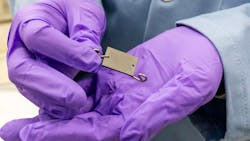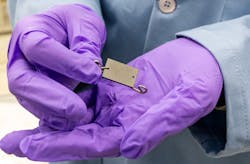Researchers Tackle Corrosion, Another Hurdle for Future Fusion Reactors
Engineers and scientists in U.S. labs have long been working on making fusion a practical and economic fusion reactor that could be a source of carbon-free energy. One of the many challenges in reaching that goal is determining how to handle corrosion in the reactor.
For example, one approach to producing the tritium, a heavy-hydrogen isotope that will be one of the fuels used in fusion reactors, uses high-energy neutrons accelerated in the reactor to convert meal lithium into tritium. In this approach, liquid lead-lithium is channeled through the reactor’s blanket, the reactor’s inner walls that are made of specialized steel with silicon carbide flow channels. Unfortunately, the constant flow of lead-lithium will gradually corrode away the steel. Minimizing that corrosion is a crucial step for a viable fusion power plant.
Many factors contribute to how the corrosion occurs, including the composition of the exposed materials; how long they are exposed; how fast the liquid flows; the strong magnetic fields used to control and confine the plasma; the temperature; and impurities in the system.
To explore how the corrosion occurs, a team of researchers at Oak Ridge National Lab built a series of flow loops to test fusion materials under various conditions, including temperatures up to 700°C. The researcher inserted specimens of a steel similar to what would be used for components in a fusion device into the loops, along with samples silicon carbide. According to current fusion designs, the silicon carbide reduces the pressure drop in the lead-lithium flow by electrically isolating the fluid from the steel walls. This lets the three materials coexist and interact, with the lead-lithium mediating between the steel and silicon carbide.
After each 1,000-hr experiment, samples were tested to see if they had become brittle and how much mass had dissolved in the liquid lead lithium—or how much was added by newly formed compounds.
In the first experiment, the team found that iron and chromium from the steel dissolved in the liquid, which then reacted with the silicon carbide to form intermetallic compounds, silicides, and iron and chromium carbides. As these newly formed compounds flowed through the loop, they accumulated on the silicon carbide samples in the cooler end of the loop, creating a layer a couple of hundred microns thick.
The team discovered that discovered that lowering the loop’s high temperature from 700° to 650°C led to a much slower buildup of the newly formed compounds.
As iron and chromium reacted with the silicon carbide, the lead-lithium dramatically corroded the steel specimens to where they practically disappeared.
In another set of experiments, the team coated the steel with a thin layer of aluminum to protect it from the corrosive liquid, the first time this has been done in a flowing experiment. The results were encouraging in that none of the coated steel specimens were corroded significantly.
In upcoming experiments, the team plans to use a thinner layer of aluminum to minimize how much of the aluminum ends up in the system. It also plans to double the length of experiments to 2,000 hours to better study the growth of the reactant layer on the cold side of the loop.
The team is also using computer models and simulations to predict the corrosion lifetimes of fusion materials at 50,000 hours or more. But continued experiments and new testing environments are needed to validate and improve these models.
Currently, a planned goal is to develop a flow loop which would use magnets to measure the effect of magnetic fields on corrosion rates.

